初中英语全英说课稿
初中英语全英说课稿优秀8篇
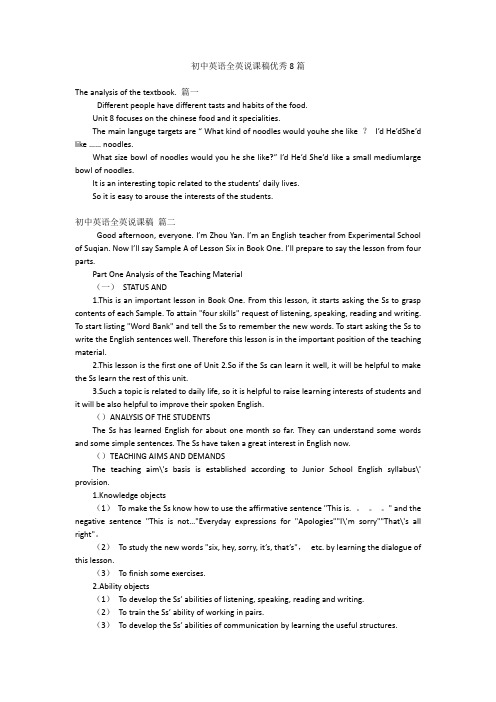
初中英语全英说课稿优秀8篇The analysis of the textbook. 篇一Different people have different tasts and habits of the food.Unit 8 focuses on the chinese food and it specialities.The main languge targets are “ What kind of noodles would youhe she like ?I’d He’dShe’d like …… noodles.What size bowl of noodles would you he she like?” I’d He’d She’d like a small mediumlarge bowl of noodles.It is an interesting topic related to the students’ daily lives.So it is easy to arouse the interests of the students.初中英语全英说课稿篇二Good afternoon, everyone. I’m Zhou Yan. I’m an English teacher from Experimental School of Suqian. Now I’ll say Sample A of Lesson Six in Book One. I’ll prepare to say the lesson from four parts.Part One Analysis of the Teaching Material(一)STATUS AND1.This is an important lesson in Book One. From this lesson, it starts asking the Ss to grasp contents of each Sample. To attain "four skills" request of listening, speaking, reading and writing. To start listing "Word Bank" and tell the Ss to remember the new words. To start asking the Ss to write the English sentences well. Therefore this lesson is in the important position of the teaching material.2.This lesson is the first one of Unit 2.So if the Ss can learn it well, it will be helpful to make the Ss learn the rest of this unit.3.Such a topic is related to daily life, so it is helpful to raise learning interests of students and it will be also helpful to improve their spoken English.()ANALYSIS OF THE STUDENTSThe Ss has learned English for about one month so far. They can understand some words and some simple sentences. The Ss have taken a great interest in English now.()TEACHING AIMS AND DEMANDSThe teaching aim\'s basis is established according to Junior School English syllabus\' provision.1.Knowledge objects(1)To make the Ss know how to use the affirmative sentence "This is. 。
初中英语阅读全英说课稿
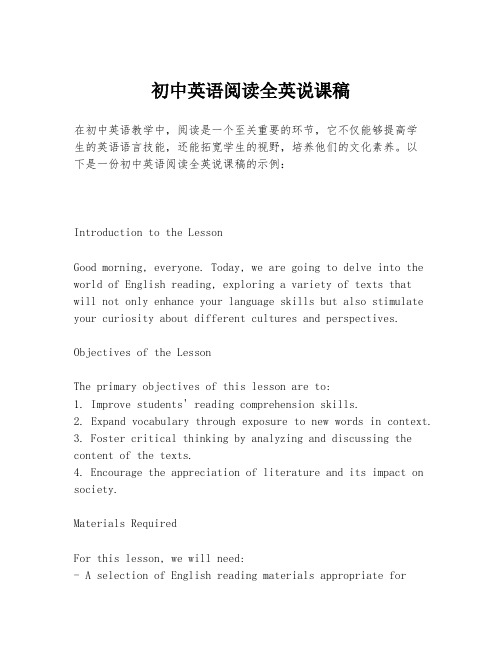
初中英语阅读全英说课稿在初中英语教学中,阅读是一个至关重要的环节,它不仅能够提高学生的英语语言技能,还能拓宽学生的视野,培养他们的文化素养。
以下是一份初中英语阅读全英说课稿的示例:Introduction to the LessonGood morning, everyone. Today, we are going to delve into the world of English reading, exploring a variety of texts thatwill not only enhance your language skills but also stimulate your curiosity about different cultures and perspectives.Objectives of the LessonThe primary objectives of this lesson are to:1. Improve students' reading comprehension skills.2. Expand vocabulary through exposure to new words in context.3. Foster critical thinking by analyzing and discussing the content of the texts.4. Encourage the appreciation of literature and its impact on society.Materials RequiredFor this lesson, we will need:- A selection of English reading materials appropriate forthe level of the students, which may include short stories, articles, and poems.- Handouts with comprehension questions and vocabulary exercises.- A whiteboard and markers for note-taking and discussion.Teaching Procedures1. Warm-up Activity (5 minutes)Begin the class with a quick vocabulary review game. Students will match new words to their definitions, setting the stage for the new vocabulary they will encounter in the reading.2. Introduction to the Text (10 minutes)Briefly introduce the text to be read, providing background information about the author and the context in which the text was written.3. Guided Reading (20 minutes)Students will read the text silently, following along with the teacher who will guide them through the reading, highlighting key vocabulary and phrases.4. Comprehension Check (15 minutes)After reading, conduct a comprehension check using the handouts provided. This will help assess students' understanding of the main ideas and details of the text.5. Vocabulary Expansion (10 minutes)Discuss new vocabulary words in the context of the text.Encourage students to use these words in sentences to reinforce their understanding.6. Group Discussion (15 minutes)Form small groups and have students discuss the themes, characters, and plot of the text. This will promote critical thinking and the ability to express opinions in English.7. Reflection and Feedback (5 minutes)Conclude the lesson by having students reflect on what they have learned and provide feedback on the reading experience.AssessmentStudents will be assessed based on their participation in discussions, the accuracy of their comprehension answers, and their ability to use new vocabulary in context.ConclusionReading in English is a journey of exploration and discovery. By engaging with diverse texts, we not only improve our language proficiency but also enrich our understanding of the world around us. I look forward to our shared journey through the pages of these fascinating texts.This lesson plan is designed to be interactive and student-centered, with a focus on developing both language skills and a deeper appreciation for the art of reading.。
全英初中说课稿
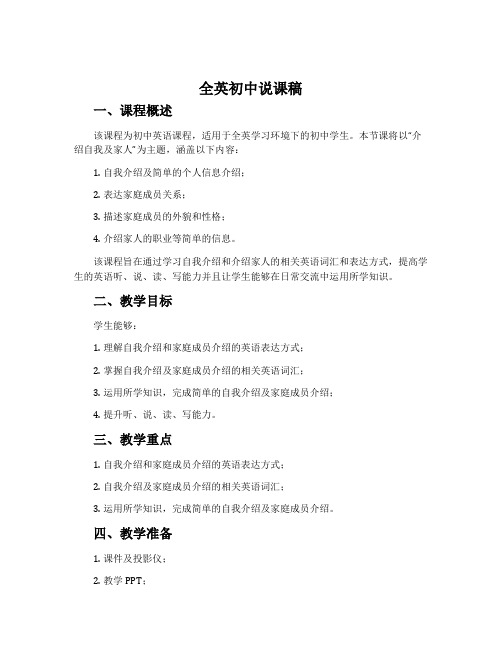
全英初中说课稿一、课程概述该课程为初中英语课程,适用于全英学习环境下的初中学生。
本节课将以“介绍自我及家人”为主题,涵盖以下内容:1.自我介绍及简单的个人信息介绍;2.表达家庭成员关系;3.描述家庭成员的外貌和性格;4.介绍家人的职业等简单的信息。
该课程旨在通过学习自我介绍和介绍家人的相关英语词汇和表达方式,提高学生的英语听、说、读、写能力并且让学生能够在日常交流中运用所学知识。
二、教学目标学生能够:1.理解自我介绍和家庭成员介绍的英语表达方式;2.掌握自我介绍及家庭成员介绍的相关英语词汇;3.运用所学知识,完成简单的自我介绍及家庭成员介绍;4.提升听、说、读、写能力。
三、教学重点1.自我介绍和家庭成员介绍的英语表达方式;2.自我介绍及家庭成员介绍的相关英语词汇;3.运用所学知识,完成简单的自我介绍及家庭成员介绍。
四、教学准备1.课件及投影仪;2.教学PPT;3.白板和笔等;4.学生练习用的英语词汇卡片。
五、教学过程第一步:导入新知识引导学生回忆上学期学过的自我介绍内容和和家庭成员介绍内容,然后告诉学生本次课程我们会一起学习如何用英语表达自我介绍及介绍家人。
第二步:讲解新知识导入新知识后,老师将通过课件和教学PPT介绍英语中描述外貌和性格方面的词汇。
例如:hair(头发)、eyes(眼睛)、face(脸)等等。
然后,老师将以图片等形式,向学生展示外国人常用的自我介绍方式,介绍英语中对于介绍家庭成员职业等信息的表达方式。
第三步:完成练习在学习新知识后,老师将通过练习让学生掌握并巩固新学的知识。
练习过程中,学生将通过使用卡片上分类好的英语词汇,完成自我和家庭成员的描述。
老师会对学生的发音和英语语法进行指导。
第四步:展示才艺最后,老师将邀请一些学生展示自己的才艺,例如:口语表达、词汇积累和听力等等。
六、教学评估1.通过互动讨论,单人和小组练习等形式,检测学生在英语听、说、读和写方面的掌握程度,评估他们取得的进步;2.观察学生在展示才艺时表现的口语和语法的准确性,评估学生在英语方面的表达能力。
初中英语全英说课稿
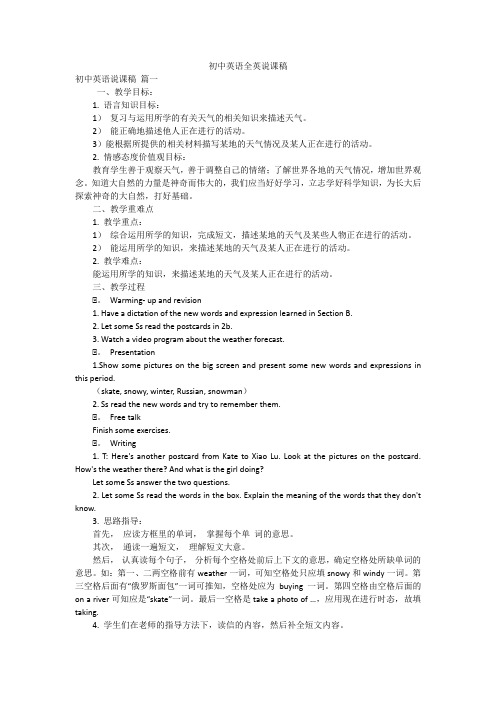
初中英语全英说课稿初中英语说课稿篇一一、教学目标:1. 语言知识目标:1)复习与运用所学的有关天气的相关知识来描述天气。
2)能正确地描述他人正在进行的活动。
3)能根据所提供的相关材料描写某地的天气情况及某人正在进行的活动。
2. 情感态度价值观目标:教育学生善于观察天气,善于调整自己的情绪;了解世界各地的天气情况,增加世界观念。
知道大自然的力量是神奇而伟大的,我们应当好好学习,立志学好科学知识,为长大后探索神奇的大自然,打好基础。
二、教学重难点1. 教学重点:1)综合运用所学的知识,完成短文,描述某地的天气及某些人物正在进行的活动。
2)能运用所学的知识,来描述某地的天气及某人正在进行的活动。
2. 教学难点:能运用所学的知识,来描述某地的天气及某人正在进行的活动。
三、教学过程Ⅰ。
Warming- up and revision1. Have a dictation of the new words and expression learned in Section B.2. Let some Ss read the postcards in 2b.3. Watch a video program about the weather forecast.Ⅰ。
Presentation1.Show some pictures on the big screen and present some new words and expressions in this period.(skate, snowy, winter, Russian, snowman)2. Ss read the new words and try to remember them.Ⅰ。
Free talkFinish some exercises.Ⅰ。
Writing1. T: Here's another postcard from Kate to Xiao Lu. Look at the pictures on the postcard. How's the weather there? And what is the girl doing?Let some Ss answer the two questions.2. Let some Ss read the words in the box. Explain the meaning of the words that they don't know.3. 思路指导:首先,应读方框里的单词,掌握每个单词的意思。
初中英语全英文说课稿
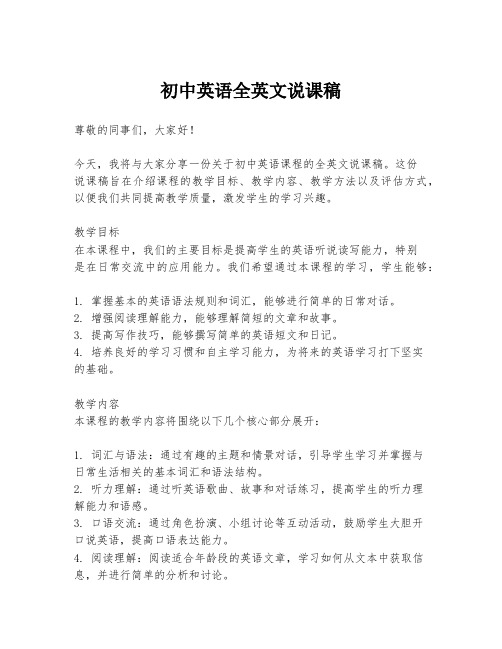
初中英语全英文说课稿尊敬的同事们,大家好!今天,我将与大家分享一份关于初中英语课程的全英文说课稿。
这份说课稿旨在介绍课程的教学目标、教学内容、教学方法以及评估方式,以便我们共同提高教学质量,激发学生的学习兴趣。
教学目标在本课程中,我们的主要目标是提高学生的英语听说读写能力,特别是在日常交流中的应用能力。
我们希望通过本课程的学习,学生能够:1. 掌握基本的英语语法规则和词汇,能够进行简单的日常对话。
2. 增强阅读理解能力,能够理解简短的文章和故事。
3. 提高写作技巧,能够撰写简单的英语短文和日记。
4. 培养良好的学习习惯和自主学习能力,为将来的英语学习打下坚实的基础。
教学内容本课程的教学内容将围绕以下几个核心部分展开:1. 词汇与语法:通过有趣的主题和情景对话,引导学生学习并掌握与日常生活相关的基本词汇和语法结构。
2. 听力理解:通过听英语歌曲、故事和对话练习,提高学生的听力理解能力和语感。
3. 口语交流:通过角色扮演、小组讨论等互动活动,鼓励学生大胆开口说英语,提高口语表达能力。
4. 阅读理解:阅读适合年龄段的英语文章,学习如何从文本中获取信息,并进行简单的分析和讨论。
5. 写作技巧:通过写作练习,如写日记、书信和短文,帮助学生提高写作组织能力和表达能力。
教学方法为了实现上述教学目标,我们将采用以下教学方法:1. 互动式教学:通过小组合作和角色扮演等活动,让学生在实际交流中学习和使用英语。
2. 多媒体辅助:利用视频、音频和图片等多媒体资源,使课堂内容更加生动有趣。
3. 任务型教学:设计贴近学生生活的任务,如购物、旅游等情景模拟,让学生在完成任务的过程中学习英语。
4. 个性化指导:针对学生的不同需求和水平,提供个性化的辅导和支持。
评估方式为了全面了解学生的学习进度和效果,我们将采取以下评估方式:1. 课堂表现:观察学生在课堂上的参与度和互动情况,评估他们的学习态度和口语表达能力。
2. 作业与练习:定期布置作业和练习,检查学生对课堂内容的掌握情况和自主学习能力。
初中英语全英说课稿优秀9篇
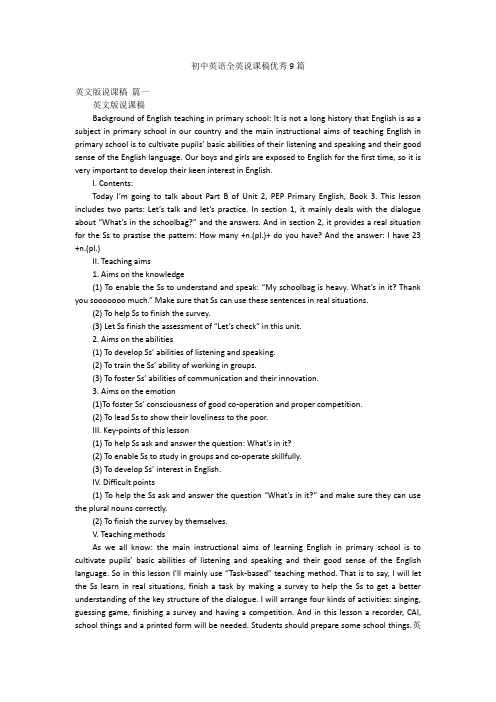
初中英语全英说课稿优秀9篇英文版说课稿篇一英文版说课稿Background of English teaching in primary school: It is not a long history that English is as a subject in primary school in our country and the main instructional aims of teaching English in primary school is to cultivate pupils’ basic abilities of their listening and speaking and their good sense of the English language. Our boys and girls are exposed to English for the first time, so it is very important to develop their keen interest in English.I. Contents:Today I’m going to talk about Part B of Unit 2, PEP Primary English, Book 3. This lesson includes two parts: Let’s talk and let’s practice. In section 1, it mainly deals with the dialogue about “What’s in the schoolbag?” and the answers. And in section 2, it provides a real situation for the Ss to prastise the pattern: How many +n.(pl.)+ do you have? And the answer: I have 23 +n.(pl.)II. Teaching aims1. Aims on the knowledge(1) To enable the Ss to understand and speak: “My schoolbag is heavy. What’s in it? Thank you sooooooo much.” Make sure that Ss can use these sentences in real situations.(2) To help Ss to finish the survey.(3) Let Ss finish the assessment of “Let’s check” in this unit.2. Aims on the abilities(1) To develop Ss’ abilities of listening and speaking.(2) To train the Ss’ ability of working in groups.(3) To foster Ss’ abilities of communication and their innovation.3. Aims on the emotion(1)To foster Ss’ consciousness of good co-operation and proper competition.(2) To lead Ss to show their loveliness to the poor.III. Key-points of this lesson(1) To help Ss ask and answer the question: What’s in it?(2) To enable Ss to study in groups and co-operate skillfully.(3) To develop Ss’ interest in English.IV. Difficult points(1) To help the Ss ask and answer the question “What’s in it?” and make sure they can use the plural nouns correctly.(2) To finish the survey by themselves.V. Teaching methodsAs we all know: the main instructional aims of learning English in primary school is to cultivate pupils’ basic abilities of listening and speaking and their good sense of the English language. So in this lesson I’ll mainly use “Task-based” teaching method. That is to say, I will let the Ss learn in real situations, finish a task by making a survey to help the Ss to get a better understanding of the key structure of the dialogue. I will arrange four kinds of activities: singing, guessing game, finishing a survey and having a competition. And in this lesson a recorder, CAI, school things and a printed form will be needed. Students should prepare some school things.英文版英语说课稿VI. Teaching procedures and purposes of my designing.I’ll finish this lesson in five steps.Step 1. Warm-up and preview1. Free talk between T and Ss about things in the classroom.2. Sing the song together: Books and pencils.3. Do some TPR, for example: Show me your English book. Show me your crayon.4. Review the numbers by asking: “How many crayons do you have?”Purpose: It is important to form a better English learning surrounding for the Ss by singing and doing some total physical response and at the same time it provides situations to review learned knowledge for the next step.Step 2. PresentationNow I’ll mainly talk about this step.1. Present the pattern: “My schoolbag is heavy.” “What’s in it?.”(1) Show a bag and say: “Look! I have a bag.” Carry it and say: “Oh, it is heavy. My schoolbag is heavy.” Help the Ss understand the meaning with the help of my body language. Then lead the Ss to read the sentence. Make sure they can say it correctly.(2) T: My schoolbag is heavy.Open the bag and say: “What’s in it? What’s in my schoolbag?”Take out a Chinese book. Then do the action again. Let the Ss read the sentence.2. Play a guessing game. Divide the whole class into four groups to have a competition.Let them guess: What’s in the bag? How many? Purpose: To present the key structures one by one is much easier for the Ss to learn and grasp the meanings. Proper competition can arouse the Ss’ interest in English learning.3. With the help of the CAI to present the dialogue. Set a situation to help Ss understand: Two Ss are coming. One girl is carrying a heavy bag on her back. They are talking.Girl: My schoolbag is heavy.Boy: What’s in it?Girl: 20 story-books, 32 pencil, 9 rulers, 12 crayons and 30 picture-books. Etc.Boy: What will you do?Girl: They are for the poor.Boy: Great! I’ll bring some school things too.The boy comes back home and puts a lot of things into the bag. Then he goes to school again and gives them to a teacher. While he is taking them out, he is counting the numbers of all things. The teacher says: Thank you soooooooo much.4. Mention that we should take care of the poor.5. Play the cassette. Let the Ss listen and imitate the dialogue.Pay attention to their pronunciation and intonation. Purpose: CAI can provide a real situation for the Ss to understand the dialogue and the relationships between people better. Tell the Ss we should show our loveliness to the Ss.Step 3. PracticeDivide Ss into groups of six children. Each one would finish the printed form by asking and answering: How many storybooks do you have? Find out which group finishes faster. Story books picture-books sharpeners crayons pencils erasers pencil-cases rulers Chen Jie 8 24 3 32 26 4 1 3Purpose: Task-based teaching method is used here to develop Ss’ ability of communication and also their ability of co-operation will be well trained.Step 4. AssessmentHelp Ss finish “Let’s check” of this unit and workbook.Purpose: To check the knowledge Ss have learned in this period.Step 5. Add-activity1. Let Ss tell each other how many school things they have after class. Tell their parents how many school things they have at home.2. Take care of everything they have.Purpose: Revision is so important that Ss should speak English as much as they as in class or after class. It is necessary for the Ss to do some extensive exercises after class to consolidate the knowledge they learned.英文版英语说课稿初中英语说课稿篇二今天我的说课内容是新目标英语八年级上册第四单元第一课时。
初中英语全英说课稿(优秀5篇)
初中英语全英说课稿(优秀5篇)初中英语全英说课稿篇一Good morning,ladies and gentlemen!I am very pleased to have an opportunity to talk about some of myteaching ideas.The topic of this Unit is "What should I do?" from thetextbook—go for it book 8 unit 2 for junior middle school students.I’d like tosay it from 5 parts as follows:There are teaching materials,teaching methods,learningstrategies,teaching procedures and blackboard design.Now,Let’s come to the first part—Teaching materials.It includestwo parts,status and functions of the material and the teaching content.The thingsin the text book are appropriate to students’ interests,experiencesand knowledge;provide the students with opportunities to use the target languageand stimulate students to seek further information.In unit 2,Studentswill learn to talk about problems and learn to give advice to others.So it ishelpful to improve their communicative competence.Ok,second,teaching content,which includes four aspects,the key vocabulary,the targetlanguage,important and difficult points, and the teaching aims.About theteaching aims,in this unit,students will talk about problems which students come up with intheir daily lives and learn to use modal verbs "could" and "should" to makesuggestions.The second is ability aims,to improve thestudents’ abilities of listening,speaking and readingby providing various tasks.The last is the affection aims,that is,to help eachother and learn to cooperate.Next,let’s come to the second part—teaching methods.Whiledealing with this lesson,I usually adopt "Task\|based" teaching approach.It aims at providing opportunities for the learners to explore bothspoken and written language through learning activities.So,I will letthe students learn in real situations,fulfill severaltasks such as pair work or group work.And in this unit thecommunicative approach and the situational language approach will be adopted.And thefocus is on functional language usage and the ability of learners to expresstheir own ideas,feelings,attitudes,desires and needs.So combine these methods together,enable the studentsto receive,process and retain new information through "multipleintelligences"。
初中英语说课稿精选全英
初中英语说课稿精选全英Ladies and gentlemen,Today, I am excited to share with you a lesson plan that I have designed for a junior high school English class. This lesson is titled "Exploring the World of English Literature," and it is aimed at enhancing students' appreciation for English literature while improving their language skills.Objectives:1. To introduce students to various genres of English literature.2. To improve students' reading comprehension and vocabulary.3. To encourage students to express their thoughts and opinions in English.Materials:- Copies of selected English literature excerpts.- Whiteboard and markers.- Audio-visual equipment for playing literary adaptations.Warm-up Activity:We will begin the class with a brief discussion about the students' favorite books and authors. This will serve as an icebreaker and help gauge their familiarity with English literature.Introduction:I will introduce the concept of literature and its importance in our lives. We will discuss the different genres, such as poetry, prose, and drama, and their unique characteristics.Reading Comprehension:Students will be divided into small groups and given excerpts from various English literary works. They will read the excerpts silently, followed by a group discussion to answer comprehension questions and share their interpretations.Vocabulary Enhancement:We will identify and discuss new vocabulary words from the excerpts. Students will be encouraged to use these words in sentences to reinforce their understanding.Literary Analysis:Next, we will delve into the analysis of the selected literature. Students will learn about literary devices such as metaphor, simile, and personification, and how they are used in the texts.Creative Writing:To apply their learning, students will be asked to write a short paragraph inspired by one of the literary works they have read. This will help them practice using new vocabulary and literary techniques.Conclusion:We will conclude the lesson by sharing the creative writing pieces with the class. This will provide an opportunity for peer feedback and further discussion.Homework:For homework, students will be asked to choose a piece of English literature that interests them and write a brief summary and analysis, focusing on the use of language and literary devices.Assessment:The lesson will be assessed through group participation, the quality of the creative writing, and the homework assignment.I believe this lesson plan will not only improve students' English language skills but also ignite a passion for English literature. Thank you for your attention, and I look forward to implementing this lesson in the classroom.。
全英文初中英语说课稿范文
全英文初中英语说课稿范文介绍这是一份全英文的初中英语说课稿范文。
这份范文旨在帮助英语教师准备一堂初中英语课的教学讲解。
教学目标通过本课的研究,学生将能够:- 了解并掌握相关英语词汇和句型;- 进一步提高听、说、读、写的能力;- 研究并运用英语进行交流。
教学重点本节课的教学重点包括:- 新的英语单词与短语;- 对话和句子的准确表达;- 阅读与理解课文内容;- 口语表达和书写能力的提升。
教学准备在开始授课之前,教师需要准备以下教学材料:- PowerPoint幻灯片;- 学生课本和练册;- 黑板和白板擦;- 没有版权问题的相关图片。
教学过程第一阶段:导入 (5分钟)教师通过展示相关图片和用英语与学生进行简单的对话,激发学生的研究兴趣。
第二阶段:新知讲解 (15分钟)教师介绍本节课的新单词和短语,通过示范、解释并提供例句帮助学生理解和记忆。
第三阶段:对话练 (15分钟)教师与学生进行对话练,引导学生熟练运用新单词和短语,并纠正他们的发音和语法错误。
第四阶段:阅读理解 (15分钟)教师让学生阅读一篇相关短文,并提问相关问题,帮助学生理解课文内容并提高阅读理解能力。
第五阶段:口语表达 (15分钟)教师与学生进行口语对话训练,通过角色扮演和实际情境练提高学生的口语表达能力。
第六阶段:练与巩固 (10分钟)教师组织学生进行练和巩固活动,如填空题、选择题等,以检验学生对本节课内容的掌握程度。
第七阶段:作业布置 (5分钟)教师布置适当的课后作业,巩固学生对本节课内容的理解和运用。
教学评价教师可以通过观察学生在课堂上的表现、听写、口语交流等方式对学生的研究情况进行评价。
结束语通过本堂课的研究,相信学生们能够更好地掌握英语知识,提高自己的英语能力。
谢谢大家!以上是全英文初中英语说课稿范文的详细内容,希望对您有所帮助。
全英经典初中英语说课稿
(全英)经典初中英语说课稿Good afternoon, my dear judges, I am ———, from ————, it is my great honor to have this opportunity to talk about my teaching ideas. My presentation consists of five parts.Part 1 The analysis of the teaching materialThis lesson is a reading passage, which focused on the topic of __________________, such a topic is related to our daily life, so it is easy to arouse the Ss’ learning interests.My teaching objectives include the following parts.First, the knowledge objective :By the end of this lesson, Ss can learn the new words and new phrases:______________________________________ 其他参考活动:Debate----当话题有矛盾的双面Discussion——当话题是讨论解决问题Do a survey——调查Understand the main idea of the article;And master the usage of ___________________(某个语法点)Second, the Ability objective:skim for the main idea of the article andscan for the specific information,predict some information andunderstand the whole article, andenlarge the relative knowledge by reading more materials in library or from internet, write a report of the topic, etc. Third the emotional objective:to develop the spirit of cooperation through teamwork and pair-discussion;arouse Ss’ interest in English learningForth, the Cultural awarenessFifth the Important points:to get an overall understanding of the whole text,and develop their reading skills such as anticipating, skimming, scanning, summarizing language points…..…(具体课型用具体例子阐述)the usage of the______________________( 语法或句型)While the Difficult points:Are enable the Ss to use the new words and phrases to express their ideas in daily life, and develop the ability of skimming and scanning.master the usage of ____________________________( 语法或句型)根据教学过程设计的内容来决定)Part 2 The analysis of studentsThe Ss have learned English for some years. They understand some words and simple sentences. They are curious, active, and fond of game, competition, and various activities. They enjoy learning through cooperation in a relaxing atmosphere.Part 3 Teaching methodsIn this lesson, My teaching methods includeaudio-visual teaching method, communicative teaching method, and task-based teaching methods.Besides, a computer, blackboard, a tape recorder, a projector are needed as the teaching aids.Part 4 Teaching proceduresThere are five steps in my teaching procedures. But before teaching, I will divide the whole class into 4 groups to do competitions while finish different tasks in this lesson.Step 1 Warming-up and leading in (3mins)Free talk; talk something related the topic of the article.参考活动:Brainstorming, setting the scene, show pictures etc.Purpose: activate the Ss to regard the topic of ___________________(主题) and create a relaxing atmosphere. Step 2 Pre-reading (10mins)There are 3 tasks for the Ss.Do a guessing game.Show some funny pictures and sentences on PPT and then ask the Ss toGuess the meaning of the new words.Practice the new words and phrases:Match the new words and phrases with the Chinese meanings.Predicting: based on the title/ pictures on the text. ( 看具体情况而定)Purpose: through guessing, to arouse Ss learning interest, and help them to learn the new words and phrases which they may come across while reading, pave the way for the following learning and cultivate the ability of anticipating.{Meanwhi le, pronunciation of some letter strings such as “ea” (pea, tea, feast..) and “er” (cucumber…) are highlighted so as to foster students’ phonetic sensitivity.} (如果有语音教学则可渗透。
- 1、下载文档前请自行甄别文档内容的完整性,平台不提供额外的编辑、内容补充、找答案等附加服务。
- 2、"仅部分预览"的文档,不可在线预览部分如存在完整性等问题,可反馈申请退款(可完整预览的文档不适用该条件!)。
- 3、如文档侵犯您的权益,请联系客服反馈,我们会尽快为您处理(人工客服工作时间:9:00-18:30)。
Good afternoon, everyone. I’m Cui Haiy an. I’m very hap[py to stand here and share my ideas with you. Now I’ll say Unit 6 This is my sister in Book One. I’ll prepare to say this lesson from four parts. Part One Analysis of the Teaching Material(一) STATUS AND FUNCTION1.This is a very important part in Book One. From this unit , To attain “four skills” request of listening, speaking, reading and writing. To start listing “Word Bank” and tell the Ss to remember the new words. To start asking the Ss to write the English sentences well.2.This lesson is the first one of Unit 6.So if the Ss can learn it well, it will be helpful to make the Ss learn the rest of this unit.3.Such a topic is related to daily life, so it is helpful to raise learning interests of students and it will be also helpful to improve their spoken English.(二)ANALYSIS OF THE STUDENTSThe Ss has learned English for about 2 months so far. They can understand some words and some simple sentences. The Ss have taken a great interest in English now. (三)TEACHING AIMS AND DEMANDSThe teaching aim's basis is established according to Junior School English syllabus provision.1.Knowledge objects(1) To make the Ss know how to use the affirmative sentence “This is. . . .” and the plurul sentence “These are t….”(2) To study the new words:father mother sister,brother,grandfather,grandmother,friend”, etc. by learning the dialogue of this lesson.2.Ability objects(1) To develop the Ss’ abilities of listening, speaking, reading and writing.(2) To train the Ss’ ability of working in pairs.(3) To develop the Ss’ abilities of communication by learning the useful structures.3.Moral objects(1) To enable the Ss to be polite and love our families.(2) To enable the Ss to cherish the life well.(四)TEACHING KEY AND DIFFICULT POINTS1.Key points:(1).To help the Ss to communicate with each other.(2).To enable the Ss to study in groups and co-operate skillfully.(3).To develop the Ss’ interest in English.2.Difficult points:(1) How to make dialogues and act them out.(2) How to write the right whole sentences.(五) TEACHING AIDSMulti-media computer, Tape recorder, Software: Powerpoint or Authorware, some pictures and so on. They will be needed in this lesson.Part Two The Teaching Methods1. Communicative teaching method2. Audio-visual teaching method3. Task-based” teaching methodAs we all know: the main instructional aims of learning English in the Middle School is to cultivatestudents’ abilities of listening, speaking, reading, wri ting and their good sense of the English language. So in this lesson I’ll mainly use “Communicative” teaching method, “Audio-visual” teaching method and “Task-based” teaching method. That is to say, I’ll let the Ss to get a better understanding of the key structure of the dialogue. I’ll give the Ss some tasks and arrange five kinds of activities: talking, guessing games, watching CAI, acting out Sample A and having a competition.Teaching special featuresTo use these methods are helpful to develop the Ss’ thought.Part Three STUDYING WAYS1.Teach the Ss how to be successful language learners.2.Let the Ss pass \"Observation—Imitation—Practice \" to study language.3.Teach the Ss how to master dialogues and how to communicate with others.Teaching special features:Let the Ss communicate with each other and adopt competition methods to develop the Ss’ keen interest in English.Part Four Teaching ProcedureI’ll finish this lesson in four steps. First I’ll divide the Ss into four groups and bring a co mpetition into the class. At last let’s see which group is the winner.Step1 Warm-up1. Free talk between T and Ss .Such as: Hi, I’m . . . . What’s your name?This is …. How do you do?Who is he/she? How are you?Who can count from 1to 5?What’s th is in English? etc.2.A game: Ask the Ss to give T some school things. For example:T: Give me your book.(ruler, box, pen, table, knife, etc.)T: This is your book. This is not my book. It’s your book. etc.In this course I’ll ask them to make a dialog ue group by group without repetition. Find out which group will make the most dialogues.Purpose of my designing: I think it is important to form a better English learning surrounding for the Ss by imitating and at the same time it is necessary to provide situations to review learned knowledge.Step2. PresentationThis course is very important. I’ll mainly talk about this step.I’ll use CAI to present the whole dialogue. Arrange some situations to help Ss understand Sample A.First scene: There is a bag on the floor. B is picking it up and get ready to leave. Now A is talking with B.A: Hi, B. How are you today?B: I’m fine, thank you. And you?A: I’m fine, too. Oh, this is my bag.B: No, this is not your bag. It’s my bag.A: (Look closely) Oh, I’m sorry.B: That’s all right.(At the same time, C is running up and hitting A.)C: Oh, I’m sorry.A: That’s OK.I’ll write the key points on the Bb while they are watching. After watching, I’ll teach them to read the words and sentences on the Bb. Make sure they can read them well.Purpose of my designing: To present Sample A by CAI is much easier for the Ss to learn and grasp the meanings. CAI can provide a real situation with its sound and picture and it makes the relationships between the Ss better.Step3.PracticeFirst play the tape recorder. Let the Ss listen and imitate the dialogue. Pay attention to their pronunciation and intonation. In this step the Ss are required to practise the Sample in pairs by reading the dialogue aloud. This step is e mployed to make the Ss grasp the Sample .At last I’ll ask the Ss to think hard and act it out with a partner according to Sample A. Then find out which group will act it out well. I’ll give them red stars.Purpose of my designing: This step is employed to make the Ss get the general idea of the dialogue as a whole one. At the same time let the Ss have a chance to practise their listening and spoken ability.Step4.ProductionIn this step I’ll give the Ss a free space to show their abilities.Second scene: The Ss are having a picnic. It’s hot and they take off their coats and put them together. They are singing and dancing, laughing and chatting. After the picnic, they begin to look for their coats. D and E are talking. F and G are talking. etc.After wat ching, I’ll give the Ss some tasks to make similar dialogues without repetition and find out which group will make more dialogues.Purpose of my designing: “Task-based” teaching method is used here to develop the Ss’ ability of communication and also their ability of co-operation will be well trained. Tell the Ss we should be polite and take good care of our things. We should love our life. I think proper competition can arouse the Ss’ interest in English learning. If the Ss can finish this task well, they will benefit a lot in their spoken English.2.Skill 1 Model 1.I’ll ask four Ss of the groups to write these sentences on the Bb in the four lines.Then check their handwriting, correct their mistakes. Find out who will write well and whose handing is the best.3.Finish the Ss’ workbook.Purpose of my designing: To check the knowledge Ss have learned in this lesson.Step5.Homework:(1)Recite the words as many as possible after class.(2)Make a dialogue according to Sample A and write it in the exercise book.Purpose of my designing: I think homework is so important that the Ss should speak English as much as they can in class or after class. It is necessary for the Ss to do some extensive exercises after class to consolidate the knowledge they learned.Blackboard DesignLesson Six Sample ASix This is my….hey This is not your. . . .sorry It’s my. . . . Picture it’s=it is Oh,I’m sorry.that’s=that is That’s all right/OK.各位评委上午好!我是来自于永川第七中学的一名英语教师,我名叫陈妍。
